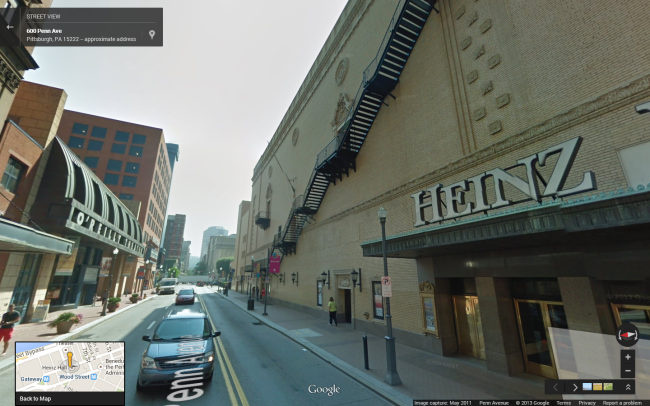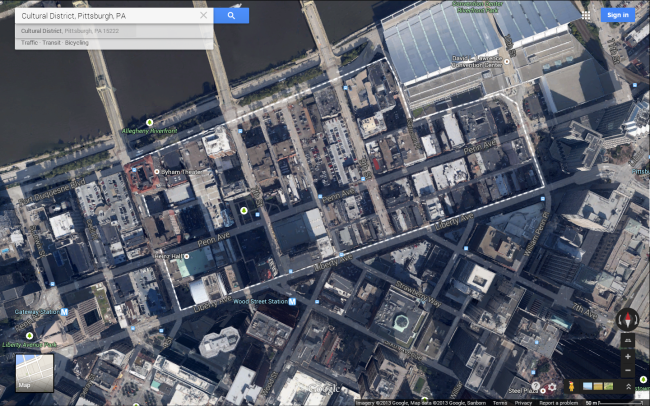Pittsburgh has a phenomenal cultural district that can be broken into the elements that Kevin Lynch describes in his essay, “The City Image and Its Elements.” This small portion of Pittsburgh has a substantial amount to do and even more to see. Its organization contains three major aspects. Firstly, the paths that allows pedestrians, public transportation, and cars to move about this area to see the various stages and theaters. These paths link this area of the city together providing the human traffic necessary for it thrive and maintain itself. The paths then connect to the nodes of the area. The nodes are the buildings that which people entire on a regular basis that house the main events. Plays, orchestras, operas, etc. can all be found within the structures. It is a conglomeration of art and entertainment where the observer can pick and choose what they desire. Containing the artistic area, are a series of edges that keep the area segregated from the city, forming a neat barrier between artistic outlets and the rest of the city. These edges are not just roads and imaginary lines but physical, natural barriers as well. Kevin Lynch breaks up the parts that make a city and defines fairly specifically, these elements can be seen in the cultural district of Pittsburgh.
Pittsburgh, as a city, has many forms of paths that Kevin Lynch describes. Paths are defined as “…the channels along which the observer customarily, occasionally, or potentially moves” (Lynch 99). Using this definition for the Cultural District, roads, sidewalks and even bus routes apply. As long as a set route permits traffic to flow it is considered a path. The significant question is what are the major paths that comprise the cultural district and how do they interact with the area and especially the people that are there. Access to area is quite easy by bus, as twelve stops lie within the area. Pedestrians, as in any city, have plenty of space along the roadside to move about the area freely. Pedestrians are an imperative part of any city structure. The paths that they take are like the arteries for an urban environment and the individuals that travel them are the blood platelets delivering life and vitality to the area. The cultural district would not be successful if it did not provide as many paths as possible to accommodate any form of traffic or transportation that may want to indulge in some type of art. Without people, the area would be a hollow husk, devoid of observers and eventually devoid of artists who would move on to share their ideas and creations somewhere else where they could maximize their audience. The purpose of these paths are to deliver observers to the artists’ creations whether it be audio or visually based. Penn Avenue is the main road that bisects the area from 6th Street all the way to 10th Street. On Penn Ave, two major nodes are across from each other, the O’Reilly Theater and the legendary Heinz Hall. Penn Ave allows access to dozens of restaurants in addition to these excellent venues. Without this path, as logical as it may seem, it would be impossible for people to go to these stages and view the art that actors and musicians alike create. These paths would be empty, however, were it not for the nodes that they connect.
People need something worthwhile in order for them to actually visit an area. They must have a need to satisfy, whether it be entertainment, food, work, or any other need that motivates them sufficiently to exert the energy needed to go somewhere. Individuals will not interact with the city unless there is sufficient reasoning to do so, the benefit of going out, exploring, and enjoying the area must outweigh the cost of the effort and money it costs to do so. Nodes are such attractions that people flock to in order to satisfy a certain need. Kevin Lynch’s definition of a node is “…the strategic spots in a city into which an observer can enter, and which are the intensive foci to and from which he is traveling” (Lynch 99). Nodes are not limited to artistic venues, restaurants, stores. Offices are nodes as well. It does not matter what happens within the building for it be a node, only that it is a city dweller’s destination or focus. People travel paths in order to fulfill their main objective, their objective being located, most likely, in a node. As mentioned before, Heinz Hall and O’Reilly Theater are significant nodes that are located on Penn Ave. Heinz Hall is a historical point in the cultural district, it is the home of the Pittsburgh Symphony and hosts dozens of shows throughout the year. Stand-up comedy, classical music, lectures, shows, jazz, and pretty much everything else can seen at this venue. The O’Reilly Theater as a node houses various plays and is a part of the Pittsburgh Public Theater. These nodes house enough artistic material to compel individuals to move voluntarily and enjoy the experience that they provide. On 6th Street is the Bayham Theater. The Bayham is a node that specializes in musicals and other shows like Heinz Hall. As for restaurants, they too are plentiful. 6th Street has everything from Indian cuisine, to Italian restaurants, to casual bars, it can all be found there. These nodes satisfy two major needs, art and food. Dinner and a show can mean a difficult choice because of the variety present in the Cultural District. These nodes are then surrounded by a series of edges that contains all of this rich city space in a neat package.
Edges are lines that contain and separate one space from another. The definition to adhere to when defining edges is, “… linear elements not used or considered as paths by the observer. They are the boundaries between two phases, linear breaks in continuity, shores, railroad cuts, edges of development, walls” (Lynch 99). They can consist of any feature, be it man-made or natural. In this instance, the Pittsburgh’s Cultural District is actually recognized by Google Maps. It’ll even draw out a set of imaginary lines where the area is. What neighbors the district, is mostly offices and a variety of other districts, including Market Square and North Shore. There are four sides to the cultural district and each presents its own edge. Each edge is new type of district and presents a new experience for a traveler in the area. Paths cannot be defined as edges so the space described by Google Maps is not applicable in this instance. The northern edge is Allegheny River. This edge divides the Cultural District from the general area of the North Shore. This water feature is an excellent example of an edge because it unusable space for the most part. It only becomes a path by boat, which a minority of people have within the area. It can become a path but it is unlikely that an attendee at a ballet or an orchestra would like to swim across to enjoy a Steelers game. The western edge is a dramatic change. Instead of music and art venues, travelling down Penn Ave will lead into office spaces and corporate facilities, a much duller environment by comparison to the posters of upcoming shows hanging around the corners of theaters. The transition is slow traveling down Penn Ave but jolting when it is realized. The southern edge is more subtle in approach than the change in building type for the west. The roads are no longer perpendicular to the river and the area feels off-center from the cultural district. Fifth Avenue, Sixth Avenue, Strawberry Way, and 7th Ave connect at a 45 degree angle to Liberty Ave. This may not seem like a dramatic change, but it is very apparent from an aerial view. The paths themselves are not the edge, rather the change in continuity of the connections of the paths. This creates a noticeable square block that is the Cultural District. The eastern edge is most noticeably defined by the David L. Lawrence Convention Center. This ominously large building looms over the district as a the start of a divider between the Cultural District and the Strip. The Eastern side is also defined by the large skyscraper on 10th Street that is a sudden change from the smaller buildings that lie nearby. It too reminds travelers that they are no longer in the same area and can expect to see a different type of space. These edges enclose the paths and nodes that make up the Cultural District from the rest of the city.
Pittsburgh is a city that offers many forms of entertainment and many forms of work. These areas, however, are segregated from each other. The Cultural District is one of these areas and it is absolutely saturated with things to do and places to see. It is a self-contained home for a lot of the arts in Pittsburgh. Kevin Lynch’s defining elements of a city can be seen in this area as well. His concept of paths are found in the streets and bus routes that go through the area. Nodes of notable interest are abundant and keep the paths filled with eager traffic, wanting to indulge in what the area has to offer. Finally, a series of edges keeps the area contained and separated from the rest of the city. Kevin Lynch’s essay “The City Image and Its Elements,” is applicable to one of the more interesting areas of the Pittsburgh region for its use of paths, nodes, and edges just like many other parts of Pittsburgh.
Works Cited
Lynch, Kevin. “The City Image and Its Elements”. The City Reader. Eds. Richard T. LeGates and Frederic Stout. New York: Routledge, 1996. pp. 499-509. Print. The City and Its Image
Mumford, Lewis. “What is a City?”. The City Reader. Eds. Richard T. LeGates and Frederic Stout. New York: Routledge, 1996. pp. 91-95. Print. What is a City?
“Pittsburgh, Pennsylvania.” Map. Google Maps. Google, 2013. Web. 17 Dec. 2013.


